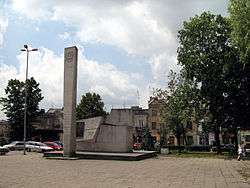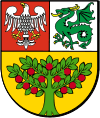Grójec
| Grójec | ||
|---|---|---|
|
Main square with monument to victims of World War II | ||
| ||
 Grójec | ||
| Coordinates: 51°51′56″N 20°52′3″E / 51.86556°N 20.86750°E | ||
| Country |
| |
| Voivodeship | Masovian | |
| County | Grójec County | |
| Gmina | Gmina Grójec | |
| Established | 11th century | |
| Town rights | 1407 | |
| Government | ||
| • Mayor | Jacek Stolarski | |
| Area | ||
| • Total | 8.52 km2 (3.29 sq mi) | |
| Elevation | 153 m (502 ft) | |
| Population (2006) | ||
| • Total | 14,990 | |
| • Density | 1,800/km2 (4,600/sq mi) | |
| Time zone | CET (UTC+1) | |
| • Summer (DST) | CEST (UTC+2) | |
| Postal code | 05-600 | |
| Area code(s) | +48 48 | |
| Car plates | WGR | |
| Website | http://www.grojecmiasto.pl/ | |
Grójec [ˈɡrujɛt͡s] is a town in Poland. Located in the Masovian Voivodeship, about 40 kilometres (25 miles) south of Warsaw. It is the capital of Grójec County. It has about 14,875 inhabitants (2004). Grójec surroundings are considered to be the biggest apple-growing area of Poland. It is said that the region makes up also for the biggest apple orchard of Europe. Statistically, every third apple sold in Poland is grown in Grójec – a unique local microclimate provides for their beautiful red colour.[1]
World War II
In July 1940, during the Nazi Occupation of Poland, German authorities established a Jewish ghetto in Grójec,[2] in order to confine its Jewish population for the purpose of persecution and exploitation.[3] The ghetto was liquidated in September 1942, when all its 5,200–6,000 inhabitants were transported in cattle trucks to Warsaw Ghetto, the largest ghetto in all of Nazi occupied Europe with over 400,000 Jews crammed into an area of 1.3 square miles (3.4 km2). From there, most inmates were sent to Treblinka extermination camp.[4][5][6][7]
Famous people born in Grójec
- Piotr Skarga - a Polish Jesuit
International relations
Twin towns – Sister cities
Grójec is twinned with:
 Spišská Nová Ves, Slovakia
Spišská Nová Ves, Slovakia
See also
Notes and references
- ↑ Michał Mackiewicz, "Okolice Grójca." Mazowiecki Urząd Wojewódzki w Warszawie. (Polish)
- ↑ The statistical data compiled on the basis of "Glossary of 2,077 Jewish towns in Poland" by Virtual Shtetl Museum of the History of the Polish Jews (English), as well as "Getta Żydowskie," by Gedeon, (Polish) and "Ghetto List" by Michael Peters at www.deathcamps.org/occupation/ghettolist.htm (English). Accessed July 12, 2011.
- ↑ "The War Against The Jews." The Holocaust Chronicle, 2009. Chicago, Il. Accessed June 21, 2011.
- ↑ Warsaw Ghetto, United States Holocaust Memorial Museum (USHMM), Washington, D.C.
- ↑ Richard C. Lukas, Out of the Inferno: Poles Remember the Holocaust, University Press of Kentucky 1989 - 201 pages. Page 13; also in Richard C. Lukas, The Forgotten Holocaust: The Poles Under German Occupation, 1939-1944, University Press of Kentucky, 1986, Google Print, p.13.
- ↑ Gunnar S. Paulsson, "The Rescue of Jews by Non-Jews in Nazi-Occupied Poland," Journal of Holocaust Education, Vol.7, Nos.1&2, 1998, pp.19-44. Published by Frank Cass, London.
- ↑ Edward Victor, "Ghettos and Other Jewish Communities." Judaica Philatelic. Accessed June 20, 2011.
- Grójec city government webpage
- Jewish Community in Grójec on Virtual Shtetl
Coordinates: 51°51′56″N 20°52′03″E / 51.86556°N 20.86750°E


